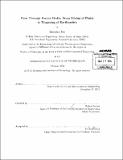Flow through porous media : from mixing of fluids to triggering of earthquakes
Author(s)
Jha, Birendra, Ph. D. Massachusetts Institute of Technology. Department of Civil and Environmental Engineering
DownloadFull printable version (21.52Mb)
Alternative title
From mixing of fluids to triggering of earthquakes
Other Contributors
Massachusetts Institute of Technology. Department of Civil and Environmental Engineering.
Advisor
Ruben Juanes.
Terms of use
Metadata
Show full item recordAbstract
Enhanced oil recovery by displacing oil with solvents such as carbon dioxide requires development of miscibility between the two fluids to maximize the displacement efficiency. Prevention of inadvertent triggering of earthquakes due to injection or production of fluids in the underground requires understanding of coupling between flow and deformation processes. In this Dissertation, we study flow through porous media in two different contexts: effect of viscosity on mixing of fluids, and triggering of earthquakes due to coupling between flow and deformation. We show that miscible viscous fingering-the hydrodynamic instability that arises when a less viscous fluid displaces the more viscous one-can be employed as an agent for enhanced mixing in porous media flows. Based on results from high-resolution numerical simulations, we derive a macroscopic model of mixing that captures the delicate interplay between channeling of less viscous fluid and creation of interfacial area as a result of viscous fingering. The coupling between subsurface flow and geomechanical deformation is critical in the assessment of the environmental impacts of groundwater use, underground liquid waste disposal, geologic carbon dioxide storage, and exploitation of shale gas reserves. We present a new computational approach to model coupled multiphase flow and geomechanics of faulted reservoirs. We represent faults as surfaces embedded in a three-dimensional medium by using zero-thickness interface elements to accurately model fault slip under dynamically evolving fluid pressure and fault strength. We incorporate the effect of fluid pressures from multiphase flow in the mechanical stability of faults, and employ a rigorous formulation of nonlinear multiphase geomechanics that is capable of handling strong capillary effects. We develop a numerical simulation tool by coupling a multiphase flow simulator with a mechanics simulator, using the unconditionally stable fixed-stress operator split for the sequential solution of two-way coupling between flow and geomechanics. We validate our modeling approach using test cases that illustrate the onset and evolution of earthquakes from fluid injection and production.
Description
Thesis: Ph. D., Massachusetts Institute of Technology, Department of Civil and Environmental Engineering, February, 2014. Cataloged from PDF version of thesis. Includes bibliographical references (pages 153-172).
Date issued
2014Department
Massachusetts Institute of Technology. Department of Civil and Environmental EngineeringPublisher
Massachusetts Institute of Technology
Keywords
Civil and Environmental Engineering.